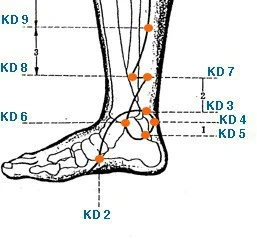Exploration of KD 3 Acupuncture Point - Brain Changes (Study)
A question very often asked of acupuncturists is, "How Does Acupuncture Work?". The truthful answer is that outside of our own theoretical framework (which is 1000's of years strong - explored in "What Does Acupuncture Treat?"), we don't really know how it works in western terms.
What we are coming to learn through a variety of studies is that first and foremost the majority of acupuncture points first stimulate areas of the brain and the that stimulation in the brain asks the body to perform and/or adjust certain functions over the next few hours to days following treatment. Some of these changes are very reliable (release proteins that release muscle tension for example) and others are more auto-regulating (raise blood pressure if low, or lower if high).
 In the study that I'm going to explore today, we will be discussing the Kidney (KD) 3 acupuncture point. From our theory site we know that the KD 3 acupuncture point is located in a depression midway between the tip of the medial malleolus and the attachment of the achilles tendon. This point is commonly used for a range of issues both within acupuncture and within acupressure.
In the study that I'm going to explore today, we will be discussing the Kidney (KD) 3 acupuncture point. From our theory site we know that the KD 3 acupuncture point is located in a depression midway between the tip of the medial malleolus and the attachment of the achilles tendon. This point is commonly used for a range of issues both within acupuncture and within acupressure.
The point is used to treat issues which arise from common kidney patterns from a Chinese Medicine perspective - kidney qi deficiency, kidney yang deficiency and/or kidney yin deficiency. This might include western issues/conditions such as anxiety, asthma, back pain, headaches, insomnia among many others. These patterns and issues are generally explored in "My Kidneys are What?".
Using a fMRI researchers looked at what areas of the brain were activated and deactivated by stimulation at the KD 3 acupuncture point. They were using healthy volunteers in a treatment group (n=15) and used a non-acupoint/sham group as a control (n=15). Within the treatment group they found specific effects on aspects of the brain that control perception, body movement, spirit and association along with changes in the visual cortex and auditory cortex. The brain changes observed in this study help to explain how the point provides beneficial changes to mood and energy levels.
Now in clinical reality, you would use KD 3 along with others in properly designed acupuncture treatment protocols to get the desired results. But it is interesting to look at the broad array of possible effects from a single point.
Besides the brain changes that were studied by these researchers, a previous study that I had written about, here, showed changes in the physical kidney chemistry from the stimulation of the KD 3 acupuncture point. From that study it was unclear whether these changes were entirely modulated by the brain or through other mechanisms, but the point remains that the internal effects of acupuncture can be quite deep and broad.
tag @yinyanghouse for questions/comments